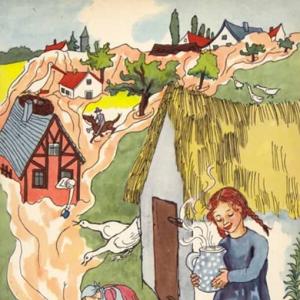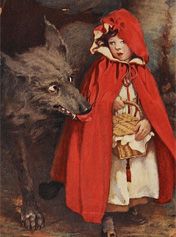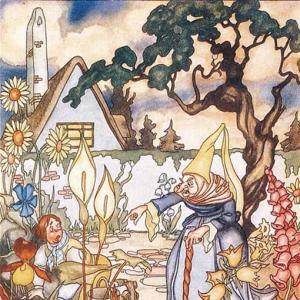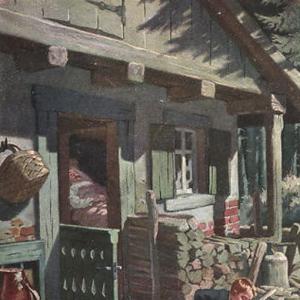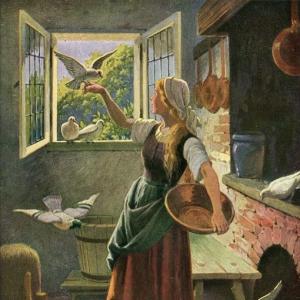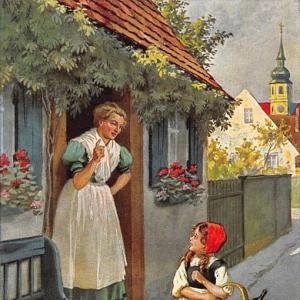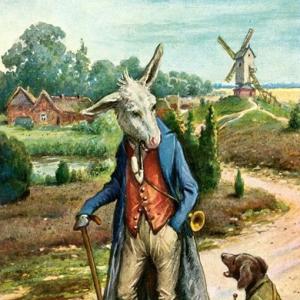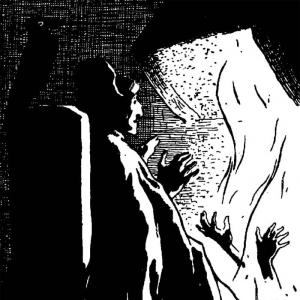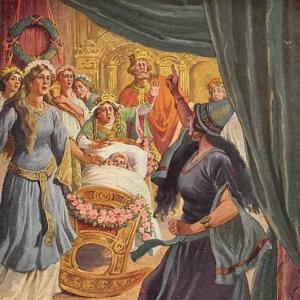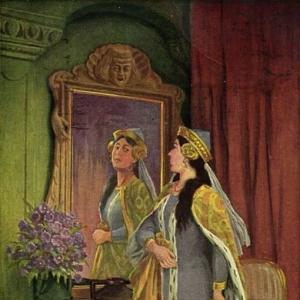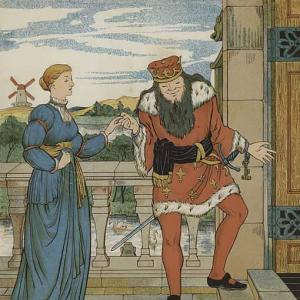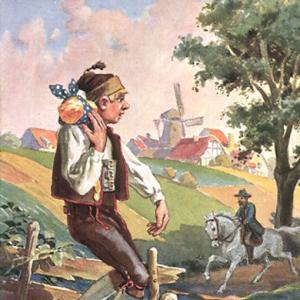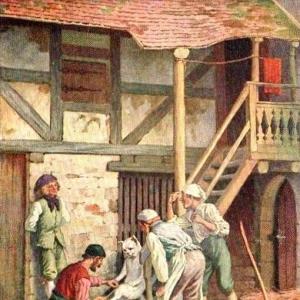Reading time for children: 5 min
Lean Lisa was of a very different way of thinking from lazy Harry and fat Trina, who never let anything disturb their peace. She scoured everything with ashes, from morning till evening, and burdened her husband, Long Laurence, with so much work that he had heavier weights to carry than an ass with three sacks. It was, however, all to no purpose, they had nothing and came to nothing. One night as she lay in bed, and could hardly move one limb for weariness, she still did not allow her thoughts to go to sleep. She thrust her elbows into her husband’s side, and said, „Listen, Lenz, to what I have been thinking: if I were to find one florin and one was given to me, I would borrow another to put to them, and thou too shouldst give me another, and then as soon as I had got the four florins together, I would buy a young cow.“ This pleased the husband right well. „It is true,“ said he, „that I do not know where I am to get the florin which thou wantest as a gift from me; but, if thou canst get the money together, and canst buy a cow with it, thou wilt do well to carry out thy project. I shall be glad,“ he added, „if the cow has a calf, and then I shall often get a drink of milk to refresh me.“ – „The milk is not for thee,“ said the woman, „we must let the calf suck that it may become big and fat, and we may be able to sell it well.“ – „Certainly,“ replied the man, „but still we will take a little milk. That will do no harm.“ – „Who has taught thee to manage cows?“ said the woman; „Whether it does harm or not, I will not allow it, and even if thou wert to stand on thy head for it, thou shouldst not have a drop of the milk! Dost thou think, because there is no satisfying thee, Long Laurence, that thou art to eat up what I earn with so much difficulty?“ – „Wife,“ said the man, „be quiet, or I will give thee a blow on thy mouth!“ – „What!“ cried she, „thou threatenest me, thou glutton, thou rascal, thou lazy Harry!“ She was just laying hold of his hair, but long Laurence got up, seized both Lean Lisa’s withered arms in one hand, and with the other he pressed down her head into the pillow, let her scold, and held her until she fell asleep for very weariness. Whether she continued to wrangle when she awoke next morning, or whether she went out to look for the florin which she wanted to find, that I know not.
 Learn languages. Double-tap on a word.Learn languages in context with Childstories.org and Deepl.com.
Learn languages. Double-tap on a word.Learn languages in context with Childstories.org and Deepl.com.Backgrounds
Interpretations
Adaptions
Summary
Linguistics
„Lean Lisa“ is a lesser-known fairy tale collected by the Brothers Grimm, Jacob (1785-1863) and Wilhelm Grimm (1786-1859), two German scholars, linguists, and cultural researchers. They were prominent figures in the Romantic movement and focused on collecting and preserving Germanic folktales and legends. The story is part of their famous collection, „Kinder- und Hausmärchen“ (Children’s and Household Tales), which was first published in 1812.
The Brothers Grimm aimed to preserve the oral tradition of storytelling in Germany and, as a result, collected over 200 tales, many of which have become well-known classics such as „Cinderella,“ „Rapunzel,“ „Snow White,“ and „Hansel and Gretel.“ The stories, initially intended for adult audiences, were later adapted to suit younger readers and have since become an integral part of children’s literature worldwide.
„Lean Lisa“ is a short tale that showcases the challenges faced by a poor, hardworking couple and the conflicts that can arise due to contrasting personalities, priorities, and values. The story reflects the cultural and societal norms of the time when it was written, giving insight into the everyday lives and struggles of ordinary people in 19th-century Germany. The Brothers Grimm’s collection of tales, including „Lean Lisa,“ continues to be cherished and studied for its literary and historical significance.
„Lean Lisa“ offers various interpretations that can be drawn from the story. Some of the key themes and interpretations are:
The Struggle of Poverty: The tale highlights the harsh realities faced by those living in poverty. Lisa’s constant worry and obsession with finding ways to improve their situation reflect the difficulties faced by people in similar circumstances. The story shows how poverty can lead to tensions and conflict within a family, as seen in Lisa and Laurence’s argument over the cow’s milk.
The Importance of Communication and Compromise: The story illustrates the need for effective communication and compromise within a relationship. Lisa and Laurence’s argument escalates due to their inability to listen to each other’s perspective and find a solution that benefits both parties. The tale serves as a reminder that open communication and willingness to compromise are essential for maintaining harmony in relationships.
Balancing Work and Personal Life: Lisa’s relentless work ethic and her inability to relax or find contentment in her life can be interpreted as a cautionary tale about the dangers of excessive work and ambition. While Lisa’s determination to improve her family’s situation is commendable, her extreme focus on work and lack of balance in her life creates tension and conflict with her husband.
Contrasting Personalities: The story presents contrasting personalities in the characters of Lean Lisa and Long Laurence. Lisa is hardworking, ambitious, and strict, while Laurence is more easygoing and content with their situation. This contrast highlights the challenges that can arise when individuals with different values and priorities attempt to navigate life together.
Overall, „Lean Lisa“ serves as a commentary on the challenges faced by those living in poverty, the need for communication and compromise in relationships, the importance of finding balance in one’s work and personal life, and the difficulties that can arise when individuals with different personalities and values try to build a life together.
„Lean Lisa“ has been adapted in various forms of media, including books, movies, and plays. Here are a few notable adaptations:
„The Thin Girl“ by Marilyn Singer: This children’s book retells the story of „Lean Lisa“ with illustrations by Sophie Blackall. The book is aimed at children ages 5-8 and emphasizes the importance of inner beauty.
„The Sorrowful Woman“ by Octavia E. Butler: This short story is a retelling of „Lean Lisa“ from a science fiction perspective. The story takes place on a distant planet and explores themes of oppression and resistance.
„Lean Lisa“ by Elizabeth Winthrop: This children’s book offers a modern twist on the classic tale. In this version, Lisa is a young girl who is teased by her classmates because of her small size. With the help of a magical fairy, Lisa gains the confidence to stand up to her bullies and find her place in the world.
„Thinnest Woman in the West“ by Lisa Soland: This play is a loose adaptation of „Lean Lisa“ that takes place during the California Gold Rush. The story follows a young woman named Annie, who is ridiculed for her thin frame. Annie’s journey to find acceptance and respect mirrors Lisa’s struggles in the original fairy tale.
„The Magic Fishbone“ by Charles Dickens: This short story is not a direct adaptation of „Lean Lisa,“ but it shares similar themes of perseverance and inner strength. The story follows a young princess who must overcome several obstacles to gain her father’s approval and marry her true love.
These adaptations demonstrate the enduring appeal of „Lean Lisa“ and its message of hope and resilience.
„Lean Lisa“ is a fairy tale by the Brothers Grimm about a hardworking and frugal woman named Lisa and her husband, Long Laurence. Lisa is the opposite of her neighbors, lazy Harry and fat Trina, as she tirelessly works and constantly seeks ways to improve her and her husband’s situation.
One night, while lying in bed and unable to sleep due to her exhaustion, Lisa comes up with a plan. She tells her husband that if she could find one florin, be given another, borrow a third, and receive a fourth from him, she would have enough money to buy a young cow. Laurence agrees with the idea, but expresses concern about where he would get the money to give her. Nonetheless, he supports her plan and looks forward to having milk from the cow.
Lisa, however, insists that they must let the calf drink the milk to grow big and fat, so they can sell it for a good price later. Laurence suggests taking a little milk for themselves, but Lisa adamantly refuses, questioning his knowledge of managing cows. This disagreement escalates into a heated argument, with Lisa accusing her husband of being a glutton and a lazy rascal. The altercation becomes physical, but Laurence eventually subdues Lisa, holding her down until she falls asleep from exhaustion.
The story ends without revealing whether Lisa continued to argue the next morning or if she went out to search for the florin she needed. The tale highlights the couple’s contrasting personalities and their intense struggle over their financial situation, emphasizing the challenges faced by those living in poverty.
The fairy tale „Lean Lisa“ by the Brothers Grimm offers a rich tapestry for linguistic analysis, revealing the interplay of character dynamics through language, dialogue, and narrative style.
Characterization through Dialogue: The characters are vividly brought to life through their interactions and the dialogue. Lean Lisa’s relentless ambition and harsh disposition are immediately apparent in her persistent and aggressive manner of speaking. Her demands and assumptions about the future, „if I were to find one florin. . . I would buy a young cow,“ depict her as someone who is always scheming and planning, yet still trapped in poverty. Long Laurence’s responses, on the other hand, reveal his passive nature. His willingness to entertain Lisa’s ambition, despite its unrealistic foundation, displays a resigned compliance.
Use of Direct Speech: The use of direct dialogue in the story breaks the narratorial flow to provide insight into the household dynamics and deep-seated frustrations of both characters. Lisa’s speech is commanding and confrontational, using imperatives and conditional clauses to express her plans and expectations. Laurence, in contrast, tends to use more conciliatory language, like „It is true“ and „I shall be glad,“ which speaks to his attempt to placate Lisa.
Narrative Voice and Tone: The narrator adopts a somewhat detached and observational tone, recounting the events with little emotional involvement. This impartiality invites readers to form their judgments about the characters. The use of irony is subtle, particularly in phrases like „it was, however, all to no purpose,“ which underscores the futility of Lisa’s schemes and labor without belaboring the point.
Symbolism and Metaphor: The tale uses symbolic language to critique and caricature human behavior. The cow and the florins represent unattainable desires and misplaced priorities, while the dialogue reveals the absurdity of the characters‘ dreams and arguments. The physical struggle between Lisa and Laurence serves as a metaphor for their incompatible aspirations and discontent.
Cultural and Social Commentary: The characters’ names, Lean Lisa and Long Laurence, reflect their physical and personality traits, employing a trope common in fairy tales to immediately establish character qualities. The story illuminates societal views on marriage, gender roles, and economic struggle during the time it was written. Lisa’s dominance in planning the household’s future reflects a reversal of traditional gender roles, while the unresolved conflict between the couple at the story’s end suggests a cyclic nature of such disputes within domestic settings.
Overall, the story’s linguistic elements work together to offer both a humorous and critical perspective on human folly, dreams, and domestic life in the context of a traditional fairy tale narrative.
Information for scientific analysis
Fairy tale statistics | Value |
|---|---|
| Number | KHM 168 |
| Aarne-Thompson-Uther-Index | ATU Typ 1430 |
| Translations | DE, EN, DA, ES, PT, IT, JA, NL, PL, RU, TR, VI, ZH |
| Readability Index by Björnsson | 35.2 |
| Flesch-Reading-Ease Index | 77.4 |
| Flesch–Kincaid Grade-Level | 8.4 |
| Gunning Fog Index | 11.2 |
| Coleman–Liau Index | 6.9 |
| SMOG Index | 8.8 |
| Automated Readability Index | 8.8 |
| Character Count | 2.342 |
| Letter Count | 1.766 |
| Sentence Count | 19 |
| Word Count | 458 |
| Average Words per Sentence | 24,11 |
| Words with more than 6 letters | 51 |
| Percentage of long words | 11.1% |
| Number of Syllables | 568 |
| Average Syllables per Word | 1,24 |
| Words with three Syllables | 18 |
| Percentage Words with three Syllables | 3.9% |

